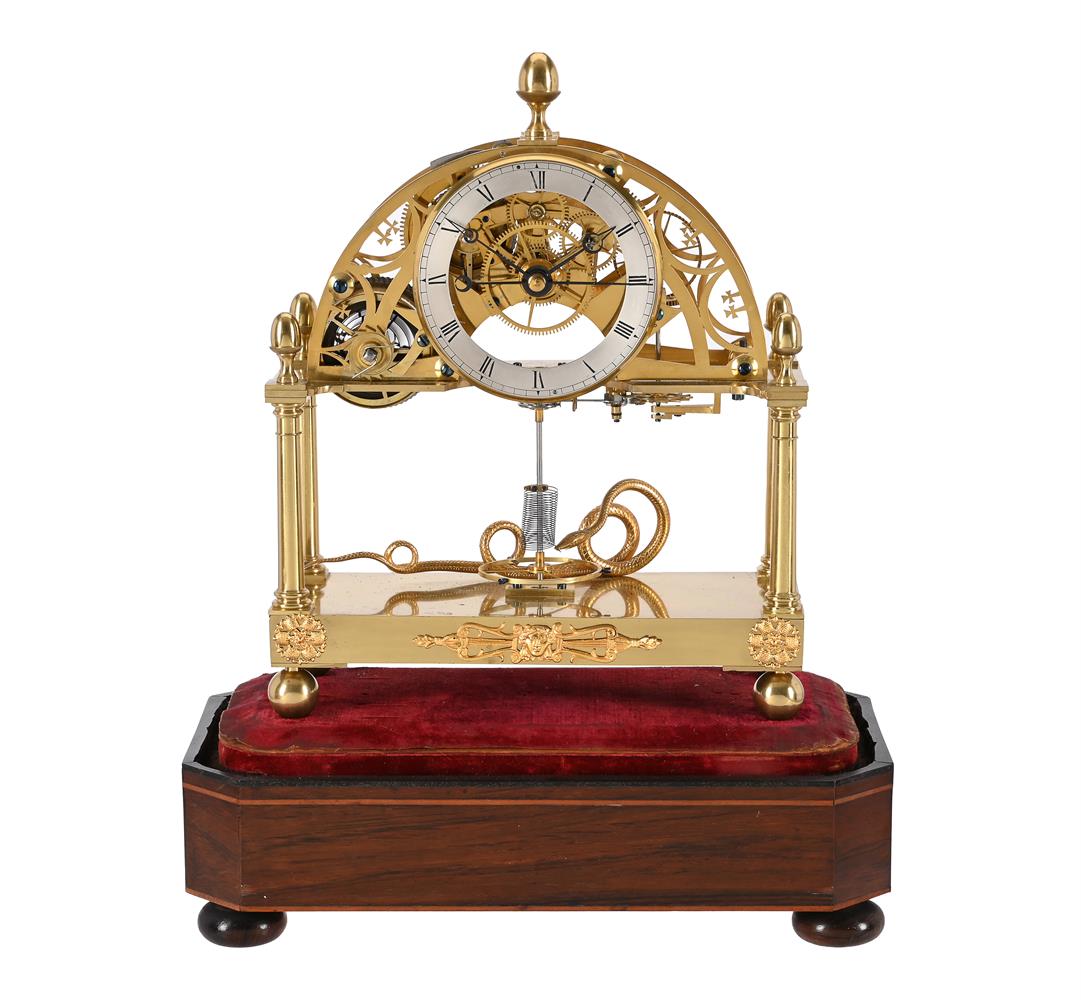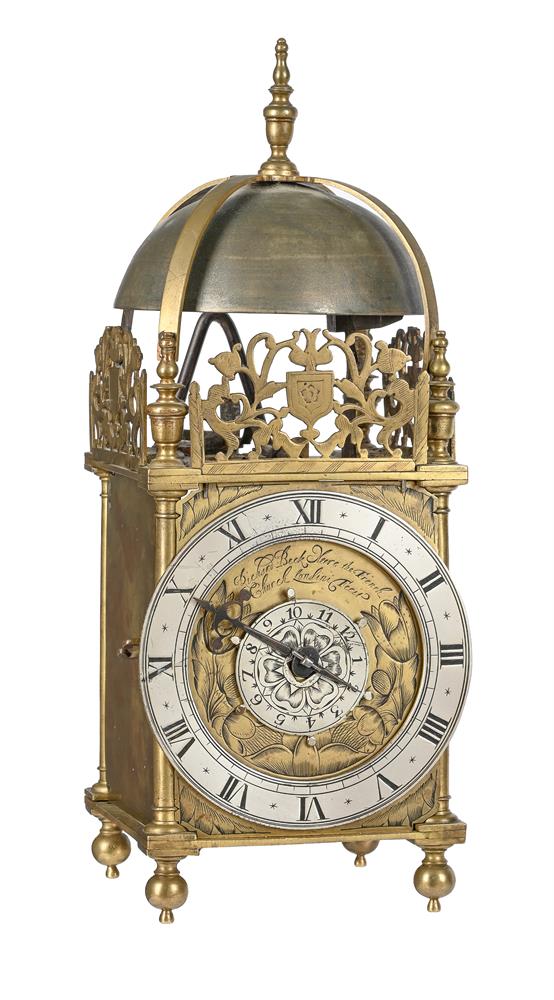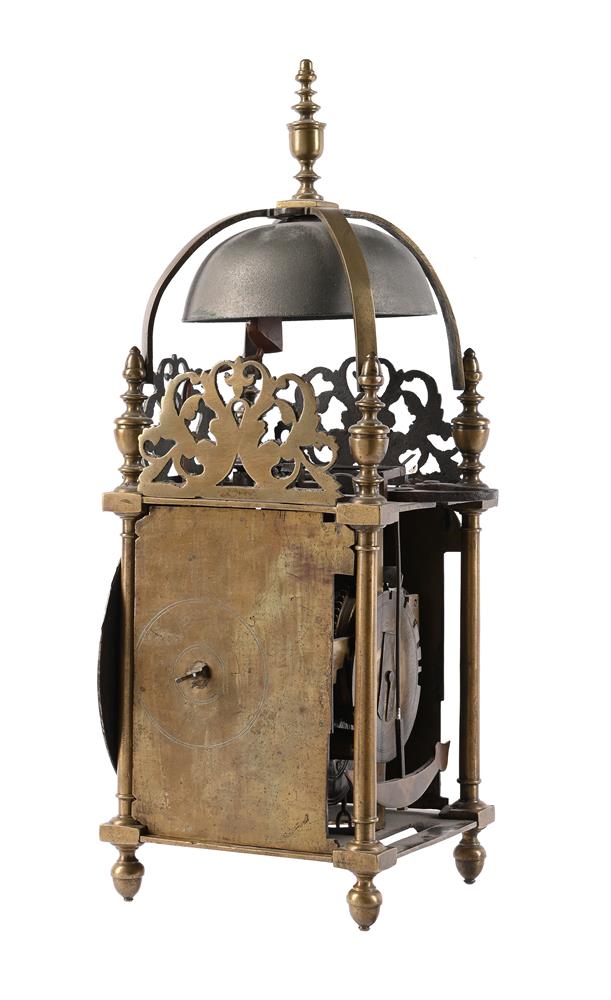A brass second period lantern clock Unsigned, mid 17th century The posted countwheel bell striking movement now with anchor escapement to the reversed going train, the dial with unusual tight concentric ring engraved centre and long-tailed iron hand within applied Roman numeral chapter ring with tied-asterisk half hour markers and deep inner quarter-hour track with the first of each quarter division hatched, the frame of second period 'Lothbury' type with column-turned corner posts beneath original early pattern shield and foliate scroll pierced frets with the front incorporating engraved initials WD between vase finials supporting a domed bell bearer above, on turned ball feet, 38cm (15ins) high. The dial of the current lot is unusual, in particular the chapter ring which has early style tied-asterisk half hour markers and a relatively deep inner quarter-hour track with the first division after each hour hatched - the reason for this is unknown. The chapter ring also has a noticeable inner-border which again is unusual, however, when this detail is considered alongside the plain dial centre then it is probably appropriate to speculate that the centre may have originally been applied with a pierced cast brass 'rosette' - similar to those seen on two lantern clocks illustrated in White, George English Lantern Clocks on pages 140-1 (Figures III/31 and 32). It is likely that such a cast brass rosette was supplied as a raw casting of relatively fixed diameter, hence the inner border to the chapter ring would need to be of appropriate internal diameter to ensure that the rosette 'filled' the space. A group of small filled holes to the dial plate near the inner edge of the chapter ring provides further strong evidence of an applied rosette, the concentric ring decoration was probably executed after a rosette was removed (early in the clock's life) in order to conceal the filled fixings and to decorate the now unadorned dial centre. Condition report disclaimer
A brass second period lantern clock Unsigned, mid 17th century The posted countwheel bell striking movement now with anchor escapement to the reversed going train, the dial with unusual tight concentric ring engraved centre and long-tailed iron hand within applied Roman numeral chapter ring with tied-asterisk half hour markers and deep inner quarter-hour track with the first of each quarter division hatched, the frame of second period 'Lothbury' type with column-turned corner posts beneath original early pattern shield and foliate scroll pierced frets with the front incorporating engraved initials WD between vase finials supporting a domed bell bearer above, on turned ball feet, 38cm (15ins) high. The dial of the current lot is unusual, in particular the chapter ring which has early style tied-asterisk half hour markers and a relatively deep inner quarter-hour track with the first division after each hour hatched - the reason for this is unknown. The chapter ring also has a noticeable inner-border which again is unusual, however, when this detail is considered alongside the plain dial centre then it is probably appropriate to speculate that the centre may have originally been applied with a pierced cast brass 'rosette' - similar to those seen on two lantern clocks illustrated in White, George English Lantern Clocks on pages 140-1 (Figures III/31 and 32). It is likely that such a cast brass rosette was supplied as a raw casting of relatively fixed diameter, hence the inner border to the chapter ring would need to be of appropriate internal diameter to ensure that the rosette 'filled' the space. A group of small filled holes to the dial plate near the inner edge of the chapter ring provides further strong evidence of an applied rosette, the concentric ring decoration was probably executed after a rosette was removed (early in the clock's life) in order to conceal the filled fixings and to decorate the now unadorned dial centre. Condition report disclaimer















Try LotSearch and its premium features for 7 days - without any costs!
Be notified automatically about new items in upcoming auctions.
Create an alert